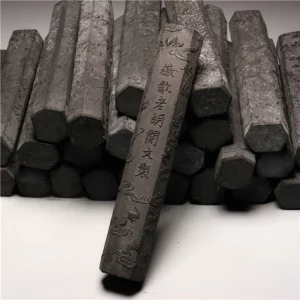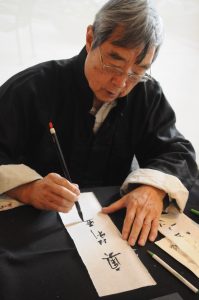The Bonesetter’s Daughter is a multigenerational epic about a family with a long and fascinating relationship with ink. When the story begins to unfold, the Liu clan is living in their small village, Immortal Heart, as they have for the past six centuries. They’re known throughout the region for their exceptional handmade ink-sticks, a family trade that goes back as far as anyone can remember.
 The men of the family work as proprietors of an ink shop in Peking, while the women of the family take on the manual labor of making the sticks. Ink-sticks were made from soot mixed with glue and oil and formed into hard sticks, which could later be ground against a stone and mixed with water to create ink. Ink compounders have experimented throughout the ages with materials from pig’s gall and oxhorn marrow to powdered pearls and jade dust. Ink makers guarded their recipes carefully—thus, the recipes for making many special inks have now been lost to the ages. As LuLing, one of the heroines of the story, puts it:
The men of the family work as proprietors of an ink shop in Peking, while the women of the family take on the manual labor of making the sticks. Ink-sticks were made from soot mixed with glue and oil and formed into hard sticks, which could later be ground against a stone and mixed with water to create ink. Ink compounders have experimented throughout the ages with materials from pig’s gall and oxhorn marrow to powdered pearls and jade dust. Ink makers guarded their recipes carefully—thus, the recipes for making many special inks have now been lost to the ages. As LuLing, one of the heroines of the story, puts it:
“It was boring work, but we were proud of our secret family recipe. An ink-stick of ours could last ten years or more. It didn’t matter how much heat or moisture or dirt from a person’s fingers soaked into the page, their words lasted, black and strong.”
LuLing’s life is, in many ways, defined by her relationship to ink and writing. Not only is the making and selling of ink part of her family’s legacy, but LuLing’s beloved nursemaid, Precious Auntie, is both an accomplished ink-maker and calligrapher, communicating largely through the written word, as she is unable to speak.
As LuLing grows and makes her way in the tumultuous world around here, her knowledge of ink-making and calligraphy affords her opportunity in a time of scarcity. Knowing how to read and write was not common for many rural Chinese women in the 1920s-40s; and she even begins the romance with her future husband as they write calligraphy side-by-side.

Calligraphy, or, literally, “beautiful writing,” is viewed not just as decorative handwriting in Chinese culture, but the supreme visual art form, ranked alongside poetry as a means of self-expression and cultivation. Indeed, the written word brings the characters in Amy Tan’s novel the complicated pain and joy of finally having the chance to see the people they’ve loved for who they truly are. As Teacher Pan tells a young LuLing:
“When you grind ink against stone you change its character, from ungiving to giving, from a single hard form to many flowing forms. But once you put the ink to paper, it becomes unforgiving again. You can’t change it back.”
It was the discovery, by her daughter, Ruth, of LuLing’s ink put to paper, her hand-penned memoirs, that spurs the very action of The Bonesetter’s Daughter to unfold. Ruth, herself, works in modern-day San Francisco as a ghostwriter. She has never learned calligraphy, and writes not by hand, but on a computer—her profession and tools highlighting her distance from, but ineffable connection to, her family legacy.
Ink, and calligraphy, are more than merely prevalent in the lives of the Liu women—they are in their bones and in their memories, not always understood, but always deeply felt.